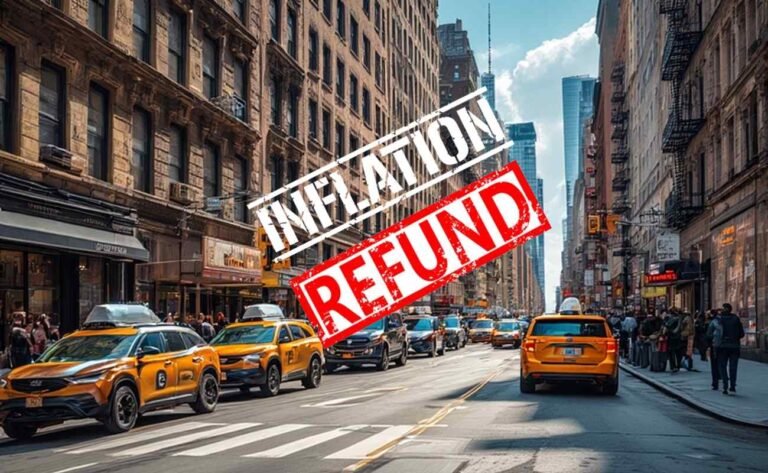Oregon One-Time Rebates ($200-$600): Your Complete Guide to Financial Relief in 2025
In 2022, Oregon rolled out a significant one-time financial relief program, distributing $600 payments to over 236,000 eligible households to support low-income workers. These payments, authorized under House Bill 4157, were designed to provide direct assistance to Oregonians who qualified for the Oregon Earned Income Tax Credit (EITC) on their 2020 tax filings and resided in the state for the last six months of 2020. While this specific program has concluded, Oregon continues to offer various rebates and incentives, particularly for energy efficiency and electric vehicle (EV) adoption, ranging from $200 to $600 in 2025. This guide dives deep into these opportunities, offering detailed lists and tables to help you navigate eligibility, application processes, and other financial relief options available in Oregon.
Whether you’re seeking rebates for EV chargers, solar installations, or other energy-efficient upgrades, this article provides a comprehensive, SEO-optimized resource to ensure you maximize your savings. From utility-specific rebates to federal tax credits, we’ll cover everything you need to know in a clear, professional format, with actionable insights and practical tips to help you secure these funds.
Understanding Oregon’s One-Time Rebate Programs
Oregon’s history of providing financial relief reflects its commitment to supporting residents during economic challenges. The 2022 one-time $600 payment was a landmark initiative, targeting low-income households who claimed the EITC. According to the Oregon Department of Revenue, one in six taxpayers statewide qualified, with Malheur County seeing the highest participation rate at 23%. These payments were fully distributed by July 31, 2022, offering a lifeline to families grappling with rising costs.
Today, Oregon’s focus has shifted toward energy-related rebates, offering $200 to $600 for initiatives like EV charger installations and solar panel systems. These programs align with the state’s environmental goals while providing financial relief. Below, we’ll break down these opportunities in detailed lists and tables, ensuring you have all the information to take advantage of these benefits.
Eligibility Criteria for Oregon Rebates
To secure Oregon’s one-time rebates, understanding eligibility is key. While the 2022 $600 payment targeted EITC recipients, current rebates focus on energy efficiency and EV adoption. Here’s a detailed breakdown:
Who Qualifies for Oregon’s Energy Rebates?
- Residents and Businesses: Most programs are open to Oregon residents, businesses, nonprofits, and government agencies.
- Utility Customers: Many rebates are tied to specific utility providers, such as Portland General Electric, Pacific Power, or Eugene Water & Electric Board.
- Income-Based Incentives: Some programs, like the Charge Ahead Rebate, prioritize low- to moderate-income households (income below 400% of the federal poverty guideline).
- Equipment Requirements: Rebates often require the installation of qualifying equipment, such as Level 2 EV chargers or EnergyStar-certified devices.
Table: Eligibility for Key Oregon Rebate Programs
| Program | Eligible Applicants | Income Requirements | Residency Requirements |
|---|---|---|---|
| Oregon Clean Vehicle Rebate (Standard) | Residents, businesses, nonprofits, agencies | None | Oregon resident or entity |
| Charge Ahead Rebate | Low- to moderate-income households | Below 400% federal poverty level | Oregon resident |
| Utility EV Charger Rebates | Utility customers (varies by provider) | Varies by program | Within utility service area |
| Solar Installation Rebates | Homeowners, renters, utility customers | Varies by utility | Within utility service area |
Oregon’s Electric Vehicle Rebate Programs
Oregon’s push for sustainability has led to robust EV rebate programs, offering $200 to $600 for charger installations and up to $7,500 for vehicle purchases. The Oregon Clean Vehicle Rebate Program (OCVRP), reopened on May 22, 2025, is a cornerstone of these efforts, administered by the Department of Environmental Quality (DEQ).
List: Key Features of the Oregon Clean Vehicle Rebate Program
- Standard Rebate: Up to $2,500 for new zero-emission vehicles with a battery capacity of 10 kWh or more; $1,500 for vehicles under 10 kWh.
- Charge Ahead Rebate: Up to $7,500 for low- to moderate-income households purchasing new or used EVs.
- Application Window: Open for vehicles purchased or leased on or after May 22, 2025, with a six-month application period post-purchase.
- Point-of-Sale Option: Available at participating dealerships for immediate savings.
- Funding: Supported by the state’s Vehicle Privilege Tax and a $31 million federal Climate Pollution Reduction Grant in 2025.
For more details on similar financial relief programs, check out our guide on New York’s $400 Inflation Relief Check, which offers insights into state-specific relief initiatives.
Table: EV Rebate Amounts by Vehicle Type
| Vehicle Type | Standard Rebate | Charge Ahead Rebate |
|---|---|---|
| New EV (≥10 kWh) | $2,500 | $7,500 (if eligible) |
| New EV (<10 kWh) | $1,500 | $7,500 (if eligible) |
| Used EV | Not available | $5,000 (if eligible) |
| Zero-Emission Motorcycle | $750 | Not available |
Utility-Specific Rebates for EV Chargers
Oregon’s utility providers offer rebates ranging from $200 to $600 for installing Level 2 EV chargers. These incentives make it easier for residents and businesses to transition to electric vehicles.
List: Utility Providers Offering EV Charger Rebates
- Central Electric Co-op:
- $150 for a NEMA 14-50 outlet.
- $200 for any Level 2 charger.
- $450 for a BPA-qualified Level 2 charger.
- Emerald PUD: Up to $200 for Wi-Fi-connected or EnergyStar Level 2 chargers.
- Eugene Water & Electric Board: $500 Smart Charge Rebate for residential customers; additional rebates for commercial customers.
- Pacific Power: Up to $500 (75% of total costs) for Level 2 home chargers.
- Tillamook PUD: $250 for residential Level 2 charger installations.
Table: Comparison of Utility EV Charger Rebates
| Utility Provider | Rebate Amount | Eligibility | Equipment Requirements |
|---|---|---|---|
| Central Electric Co-op | $150–$450 | Residential customers | NEMA 14-50 or Level 2 charger |
| Emerald PUD | Up to $200 | Residential customers | Wi-Fi or EnergyStar Level 2 charger |
| Eugene Water & Electric Board | $500 | Residential and commercial customers | Level 2 charger |
| Pacific Power | Up to $500 | Residential customers | Level 2 charger |
| Tillamook PUD | $250 | Residential customers | Level 2 charger |
Solar and Energy Efficiency Rebates in Oregon
Oregon’s commitment to clean energy extends to solar and energy efficiency rebates, offering $200 to $600 for qualifying installations. These programs, often administered by utilities or the Energy Trust of Oregon, help reduce upfront costs for homeowners and renters.
List: Solar Rebate Programs by Utility
- Portland General Electric: $900/kW for solar systems (up to $5,400); $750/kWh for storage (up to $10,000).
- Pacific Power: $1,000/kW for solar (up to $6,000); $750/kWh for storage (up to $10,000).
- Eugene Water & Electric Board: $400/kW for solar (up to $2,500).
- Salem Electric: $300/kW for solar systems under 25 kW (up to $1,500 or 50% of costs).
- City of Ashland: $600 for solar panel installations.
Table: Solar Rebate Details
| Utility Provider | Solar Rebate | Storage Rebate | Eligibility |
|---|---|---|---|
| Portland General Electric | $900/kW (up to $5,400) | $750/kWh (up to $10,000) | Residential customers |
| Pacific Power | $1,000/kW (up to $6,000) | $750/kWh (up to $10,000) | Residential customers |
| Eugene Water & Electric Board | $400/kW (up to $2,500) | Not available | Residential customers |
| Salem Electric | $300/kW (up to $1,500) | Not available | Residential customers |
| City of Ashland | $600 | Not available | Residential customers |
Federal Tax Credits Complementing Oregon Rebates
In addition to state and utility rebates, federal tax credits can further reduce costs. The Inflation Reduction Act of 2022 introduced significant incentives for EVs and energy-efficient home upgrades, which can be combined with Oregon’s programs.
List: Relevant Federal Tax Credits
- EV Tax Credit: Up to $7,500 for new EVs (income and price limits apply); $4,000 for used EVs.
- Residential Clean Energy Tax Credit (25D): 30% of costs for solar panels and battery storage systems (3 kWh or larger).
- Energy Efficient Home Improvement Tax Credit (25C): Up to $600 for electrical panel upgrades meeting National Electric Code standards (200 Amps or more).
Table: Federal vs. Oregon Rebates
| Incentive Type | Federal Amount | Oregon Amount | Key Requirements |
|---|---|---|---|
| EV Purchase | Up to $7,500 | $1,500–$7,500 | New/used EV, income/price limits |
| Solar Installation | 30% of costs | $300–$6,000 | Qualifying solar system |
| EV Charger Installation | Not available | $150–$600 | Level 2 charger, utility-specific |
How to Apply for Oregon Rebates
Applying for Oregon’s rebates is straightforward but requires attention to detail. Most programs offer online applications, and some provide point-of-sale discounts at participating dealerships.
Step-by-Step Application Guide
- Verify Eligibility: Check income, residency, and equipment requirements for the specific rebate.
- Purchase or Install: Buy or lease an eligible EV, charger, or solar system on or after the program’s start date (e.g., May 22, 2025, for OCVRP).
- Gather Documentation: Collect receipts, proof of purchase, and income verification (if applicable).
- Submit Application: Apply online through the program’s portal (e.g., DEQ for OCVRP) or utility website within six months of purchase.
- Track Status: Use online portals to monitor application progress.
For additional guidance on navigating rebate programs, explore the Energy Trust of Oregon website, a trusted resource for energy incentives.
Maximizing Your Savings: Tips and Tricks
To get the most out of Oregon’s rebates, consider these practical tips:
- Combine Incentives: Pair state rebates with federal tax credits for maximum savings.
- Check Utility Programs: Contact your utility provider for exclusive rebates not listed on state websites.
- Act Quickly: Programs like OCVRP often run out of funding within months, so apply early.
- Get Pre-Qualified: For Charge Ahead Rebates, pre-qualification ensures a smoother process at dealerships.
Common Questions About Oregon Rebates
Are Oregon’s One-Time Rebates Still Available in 2025?
The 2022 $600 EITC payment has ended, but energy-related rebates ($200–$600) for EV chargers and solar systems are ongoing. Check with your utility or the DEQ for current opportunities.
Can I Combine Multiple Rebates?
No, Oregon’s Clean Vehicle Rebate Program no longer allows stacking Standard and Charge Ahead rebates. However, you can combine state rebates with federal tax credits.
How Long Does It Take to Receive a Rebate?
Processing times vary, typically taking two to three months for post-purchase applications. Point-of-sale rebates are immediate at participating dealerships.
Why Oregon’s Rebates Matter
These rebates aren’t just about saving money—they support Oregon’s goal of reducing carbon emissions and promoting sustainable living. By investing in EVs or solar energy, you’re contributing to a cleaner environment while easing financial burdens. Programs like the Energy HIPPO (Hub for Incentive Programs and Projects in Oregon) make it easier to find and apply for these benefits, ensuring accessibility for all.
Conclusion
Oregon’s one-time rebates, from the 2022 $600 EITC payment to current $200–$600 energy incentives, offer valuable financial relief for residents and businesses. By understanding eligibility, exploring utility-specific programs, and leveraging federal tax credits, you can maximize your savings. Use the lists and tables above to navigate these opportunities and act quickly to secure funds before they run out. For more insights on financial relief, stay updated with resources like Stimulus Update and official Oregon government websites.







